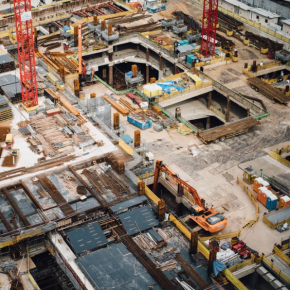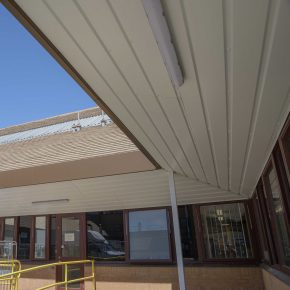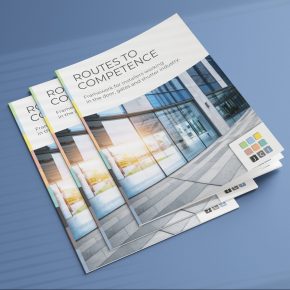
How to make construction environmentally friendly
Although the demand for oil is increasing every year and our peak-capacity for oil consumption as a planet is about to reach its peak, the global production of oil appears to decrease. Consequently, the construction industry still derives most of its energy sources from oil-based fuels.
The construction sector relies heavily upon crude oils to function as the construction process would not be able to function in its current form. Within the UK, 50% of carbon emissions are accounted for by the construction industry and machinery within the production process.
Attitudes towards carbon emissions are finally beginning to change with how pollution is beginning to impact the planet in the long-term.
Reconomy, providers of skips for hire and waste management solutions for recyclable materials, determines how eco-friendly practices can be implemented and used in the long-term to help combat climate change.
Legislation passed by the UK government is also becoming more environmentally conscious, as green processes are to be implemented within the construction of new homes and buildings.
Once construction has been completed, those construction firms are now asked to implement further green technologies to help benefit the environment that will also benefit the site in the long-term.
For a building to ecologically benefit its surroundings it should be established whether energy is being wasted during construction. During the production process, machines can more than often be overused. This leads to energy that is wasted that can never be used again. So that a motor isn’t overworked, electric vehicles or machines with hybrid-engines should be used so that when a motor is overworked – electric engines can help power and support the overall load.
Once a structure is complete, is energy being wasted within it and how is energy being used? In addition, whether materials have been locally sourced should be assessed – if they haven’t, a decision has to be made on whether they can be recycled in the future.
Recycled paper can be used as a cheap insulation alternative. Insulation that is produced for individual roofs will be more cost effective when using pre-existing materials. Timbers sourced from sustainable managed forests within the local areas solves the issues of chopping down trees that will not be replaced.
When devised into a proposed structure, drainage systems and water filtration are important to allow the reuse of water. Low energy lighting can last twice as long as regular lightbulbs, which accounts for an energy saving of 100%. Additionally, solar energy is a cheaper alternative that can help power commercial buildings or other production plants.
Latest news

26th April 2024
Alumasc Skyline and Rainwater package specified at Weston-super-Mare Hospital
A package of products from Alumasc Water Management Solutions (AWMS) has been used for the external refurbishment of the roofline at Weston General Hospital in Weston-Super-Mare.
Posted in Aluminium Products, Articles, Building Industry News, Building Products & Structures, Building Services, Building Systems, Case Studies, Cladding, Drainage Services, Drainage, Guttering, Soffits & Fascias, Fascias, Restoration & Refurbishment, Retrofit & Renovation, Roofs, Walls
26th April 2024
Hush Acoustics optimises fleet operations by securing FORS Gold accreditation
Hush Acoustics has invested in the safety and sustainability of its commercial vehicle fleet by achieving Gold status in the Fleet Operator Recognition Scheme (FORS).
Posted in Acoustics, Noise & Vibration Control, Articles, Building Industry News, Building Products & Structures, Building Regulations & Accreditations, Building Services, Ceilings, Facility Management & Building Services, Floors, Health & Safety, Insulation, Restoration & Refurbishment, Retrofit & Renovation, Site Preparation, Sustainability & Energy Efficiency, Walls, Waste Management & Recycling
26th April 2024
Safeguard Europe: Penetrating damp - how to diagnose the damage
As Safeguard gets ready to deliver another informative session of one of its most popular webinars, the company outlines some of the most common reasons for rain penetration through brickwork.
Posted in Articles, Bricks & Blocks, Building Industry Events, Building Industry News, Building Products & Structures, Building Services, Continuing Professional Development (CPD's), Damp & Waterproofing, Facility Management & Building Services, Information Technology, Posts, Render, Restoration & Refurbishment, Retrofit & Renovation, Seminars, Training, Walls
25th April 2024
ADSA: Competence Initiative Makes Progress
The Joint Competency Initiative (JCI), in which the Automatic Door Suppliers Association (ADSA) is involved, is finalising its first framework for installers within the door, gates and shutter industry.
Posted in Access Control & Door Entry Systems, Architectural Ironmongery, Articles, Building Associations & Institutes, Building Industry Events, Building Industry News, Building Products & Structures, Building Regulations & Accreditations, Building Services, Continuing Professional Development (CPD's), Doors, Facility Management & Building Services, Health & Safety, Innovations & New Products, Publications, Research & Materials Testing, Restoration & Refurbishment, Retrofit & Renovation, Security and Fire Protection, Site Preparation
 Sign up:
Sign up: